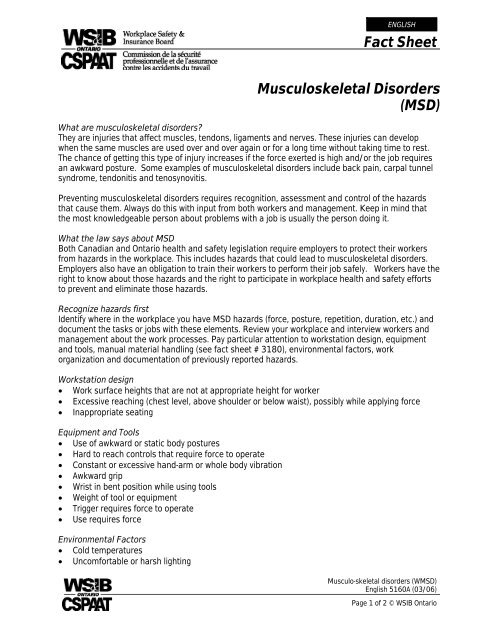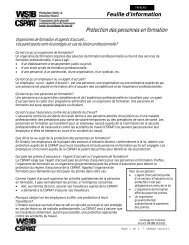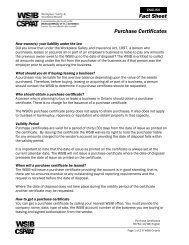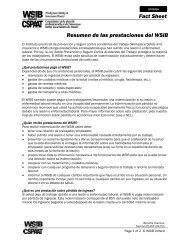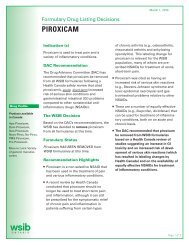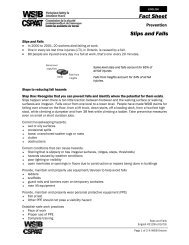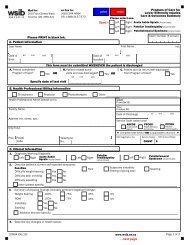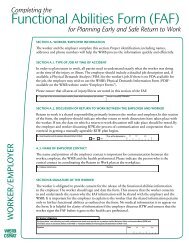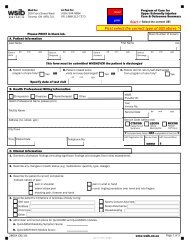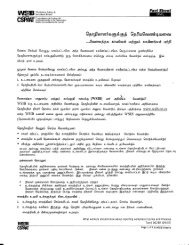Fact Sheet Musculoskeletal Disorders (MSD) - wsib
Fact Sheet Musculoskeletal Disorders (MSD) - wsib
Fact Sheet Musculoskeletal Disorders (MSD) - wsib
Create successful ePaper yourself
Turn your PDF publications into a flip-book with our unique Google optimized e-Paper software.
ENGLISH<strong>Fact</strong> <strong>Sheet</strong><strong>Musculoskeletal</strong> <strong>Disorders</strong>(<strong>MSD</strong>)What are musculoskeletal disorders?They are injuries that affect muscles, tendons, ligaments and nerves. These injuries can developwhen the same muscles are used over and over again or for a long time without taking time to rest.The chance of getting this type of injury increases if the force exerted is high and/or the job requiresan awkward posture. Some examples of musculoskeletal disorders include back pain, carpal tunnelsyndrome, tendonitis and tenosynovitis.Preventing musculoskeletal disorders requires recognition, assessment and control of the hazardsthat cause them. Always do this with input from both workers and management. Keep in mind thatthe most knowledgeable person about problems with a job is usually the person doing it.What the law says about <strong>MSD</strong>Both Canadian and Ontario health and safety legislation require employers to protect their workersfrom hazards in the workplace. This includes hazards that could lead to musculoskeletal disorders.Employers also have an obligation to train their workers to perform their job safely. Workers have theright to know about those hazards and the right to participate in workplace health and safety effortsto prevent and eliminate those hazards.Recognize hazards firstIdentify where in the workplace you have <strong>MSD</strong> hazards (force, posture, repetition, duration, etc.) anddocument the tasks or jobs with these elements. Review your workplace and interview workers andmanagement about the work processes. Pay particular attention to workstation design, equipmentand tools, manual material handling (see fact sheet # 3180), environmental factors, workorganization and documentation of previously reported hazards.Workstation design• Work surface heights that are not at appropriate height for worker• Excessive reaching (chest level, above shoulder or below waist), possibly while applying force• Inappropriate seatingEquipment and Tools• Use of awkward or static body postures• Hard to reach controls that require force to operate• Constant or excessive hand-arm or whole body vibration• Awkward grip• Wrist in bent position while using tools• Weight of tool or equipment• Trigger requires force to operate• Use requires forceEnvironmental <strong>Fact</strong>ors• Cold temperatures• Uncomfortable or harsh lightingMusculo-skeletal disorders (W<strong>MSD</strong>)English 5160A (03/06)Page 1 of 2 © WSIB Ontario
Work Organization• Large volume (especially in cases of piecework)• Inadequate or infrequent breaks• Lack of control by individual over speed of work• Lack of task variation• Inadequate training on safe work procedures and proper use of tools/equipmentDocumentation of previously reported hazards• Complaints made by workers or health office visits may signal a problem area• History of prior WSIB claims• Workplace inspectionsAssess the degree of hazardNext, determine the degree of hazard by assessing the following against your company’s standards:• Repetition -- frequency, speed and duration of the repetitive task• Posture – neutral, awkward, duration of static postures• Force – what is the force required to perform the task and the duration the force exerted before abreakControl hazards, preferably at their sourceConsider changes to• Mechanize a repetitive task or process• Design workstations and work processes using ergonomic principles• Use well maintained tools and equipment that decrease force or awkwardposition• Provide lifting devices to eliminate heavy lifting• Ensure that all employees receive comprehensive training on how to dotheir job safelyIf the hazard still exists• Use job rotation if it allows workers to use a different set of muscles• Build a variety of tasks into every job• Design work processes so that workers work in a team and they alternate tasks• Allow new or returning workers to gradually increase volume of workFor more information contact your Health and Safety Association or call the WSIB Prevention Hotlineat (416) 344-1016 (1-800-663-6639).Workplace Safety and Insurance BoardOntario’s Workplace Safety and Insurance Board (WSIB) plays a key role in the province’s occupational healthand safety system. Funded by employers, the WSIB is one of the top 10 disability insurers in North America. Inaddition to a strong prevention mandate, the WSIB provides insurance for injuries and illnesses incurred inworkplaces covered under the Workplace Safety and Insurance Act and supports early and safe return to workfor injured workers.This information is available in several languages and formats by calling 416-344-4999,toll-free 1-800-465-5606 or Telephone Service for the Deaf TTY :1-800-387-0050.Pour obtenir un exemplaire en français, composez let 1-800-465-5606.Use ergonomic principles,to avoid• awkward bodypositions• overextended andawkward reaches• repetitive or heavybending, twisting,reaching, lifting,lowering, pushing andpulling• sustained or staticexertions and/or<strong>Musculoskeletal</strong> disorders (W<strong>MSD</strong>)English 5160A (03/06)Page 2 of 2 © WSIB Ontario


